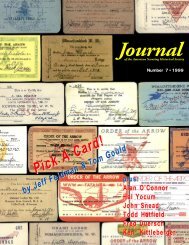Journal 6.PM - Gilwell.com!
Journal 6.PM - Gilwell.com!
Journal 6.PM - Gilwell.com!
Create successful ePaper yourself
Turn your PDF publications into a flip-book with our unique Google optimized e-Paper software.
Figure 6 – An early-type rank card.Rank andMerit Badge CardsFrom the earliest days of Scoutingwhen a scout earned a rank advancement,he not only received a patch, but also acard. These cards are significant becausethey are the official records of a scouts advancement.Early advancement/merit badge cardswere rectangular in shape; approximately3" by 5". This configuration was continueduntil the early 40’s, when the cardswere changed to the current configuration,a smaller format that is more conduciveto fitting in a wallet. An exception to thisJamboree CardsTwo types of cardswere used as part of theWorld and National Jamborees.The first categoryis attendance cards, andthe second is wide gamecards. These types ofcards were also issued forother national events,such as the National Orderof the Arrow andExplorer Conferences.Figure 8 – A Jamboree participant’scard from 1964.Figure 9 – A modern trading cardfrom the 1969 NationalJamboree.supposed to write their name and addresson the cards that they exchanged with boysfrom different parts of of the country orworld. Some examples of the content ofFigure 7 – An early Cub card.format are early Cub Scout advancementcards, which were diamond in shape (3"by 3").Many of the local Councils opted toissue their own rank and merit badge cardsrather than using the nationally distributedones. Eagle Scout cards were, and still are,only issued by the national office.Attendance cards were issued to participantsand the staff at World andNational Jamborees. There was a card issuedfor each National Jamboree,including the cancelled 1935 jamboree.Typically these cards indicated name andcity or council of the boy attending. Cardswere also issued to staff and dignitaries.The cards bore the signatures of the nationalofficers until 1964. Scouts attendingthe early World Jamborees were issuedidentification cards to indicate that theywere traveling representatives of the BoyScouts of America.Trading cards were used during widegames at the Jamborees. The wide gameswere intended to foster intermingling ofthe scouts. A scout would typically get anenvelope with a number of trading/collectingcards. They would walk around theJamboree to other sub-camps, trade cards,and <strong>com</strong>plete their set. The scouts wereFigure 9 – A modern rank card.the cards include Astronauts and earlyscouting pioneers.Card CategoriesWe had intended to title this section“Miscellaneous,” but realized that therewere too many cards to bulk into a genericsection. For this reason, we have <strong>com</strong>pileda list of all of the card categories that wehave identified to date.Our collection is limited to nationallyissued cards. Council issues are neat, butthe issues would total in the hundreds ofthousands, rather than just a few thousand.<strong>Journal</strong> of The American Scouting Historical Society7



